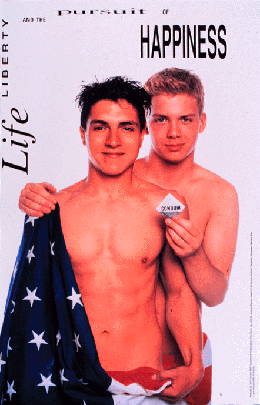![[Currents header graphic]](/homeart/currents_header.gif)
![[Currents header graphic]](/homeart/currents_header.gif)
March 16, 1998

|
|
Poster produced by the Santa Cruz AIDS Foundation
|
The AIDS epidemic has spawned a range of organizational responses, from radical groups like ACT-UP to the more staid San Francisco AIDS Foundation. The origins and strategies of both groups are among those examined in the new book Lessons from the Damned: Queers, Whores and Junkies Respond to AIDS by sociologist Nancy Stoller, a professor of community studies at UCSC.
(Selected posters and brochures analyzed in the book, with a sample of Stoller's analysis of each)After more than 15 years of the global AIDS crisis, Stoller wanted to look at the diversity of responses to the epidemic with an eye toward understanding what works for whom and why. Lessons from the Damned looks at how the most disenfranchised groups--the poor, people of color, drug users, gay men and lesbians, and women--have organized to fight the epidemic.
"These groups have successfully marketed their marginality to have a real and lasting impact on the epidemic," said Stoller, a scholar and AIDS activist with several years experience working within AIDS organizations. "Whether they're made up of gay men or former prostitutes or volunteers who knowingly break the law by distributing clean needles, they have built effective social movements around AIDS."
Stoller's book focuses on five organizations:

|
|
Nancy Stoller
|
Stoller found that organizational structure and culture have a greater impact on who is served--and how well--than do public health theories or stated organizational goals. "There are a lot of different models that work. Some are more bureaucratic than others, but clearly no one model is the best or right model," said Stoller, whose research included extensive interviews with leaders and members of AIDS organizations.
"What makes the biggest difference in terms of the programs and interventions adopted by each group are the cultural backgrounds of the most powerful people in the organization, which clearly affected the types of organizations they built."
Sometimes, Stoller found, the quality and/or success of a group's effort is affected by the choices made by its leaders, who may at times be unaware of their cultural biases or assumptions.
Stoller compares posters and brochures produced by various organizations for different groups--gays, straights, and people of color--and points out the relative strengths and weaknesses of materials that target different populations. For example, she concludes that ACT UP's posters for white gay men are graphically superior to the text-laden posters they've produced for women and people of color.
Those types of differences reflect the backgrounds of decision makers, said Stoller. "Their rhetoric is different from their programmatic expressions," she said. "Consistently, the big decisions are based on people's intuitive understandings of their own community. Sometimes that works and other times it results in an unintentionally racist or sexist product."
Stoller concludes that leaders of organizations need to be conscious of the role that class, ethnicity, and gender play in their decision making, and she offers guidelines for dealing with diversity and conflict among those on the front lines of the epidemic.
"Ultimately, we need to develop coalitions and networks of AIDS organizations," said Stoller. "No one group can do it all. In fact, my work underscores the contributions made by these diverse organizations. We need to be sure that groups are sharing their strengths and recognizing their weaknesses."